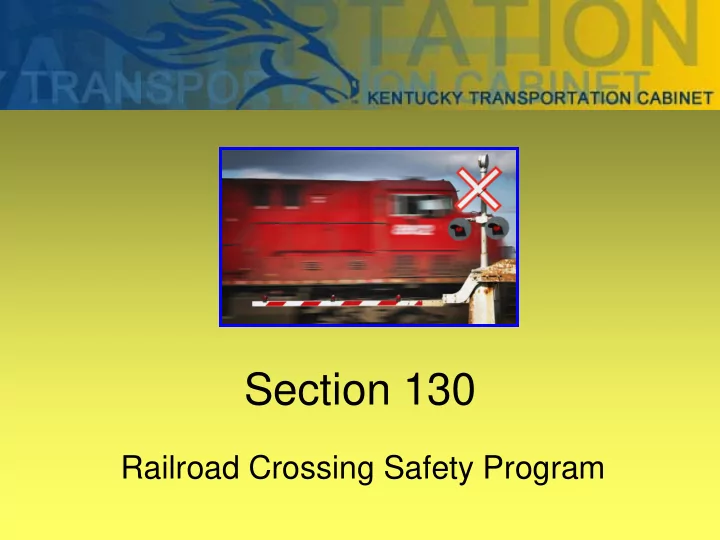

Section 130 Railroad Crossing Safety Program
Overview of the Section 130 Program Railroad Crossing Inventory • Mission: Enhance the safety of railroad crossings. • THE SAFEST CROSSING IS A CLOSED CROSSING!!! • Limited funds: upgrades and improvements to the crossings have to be made on a priority basis. • Rankings: Use a variety of physical and historical criteria. • Number: 2,036 At-grade Open Public crossings. – We do not inspect over road or under road train passes. • Goal: inspect each crossing every 3 years. • Improvements: typically include gates, lights and bells.
KyTC Partner: Federal Railroad Administration (FRA) • Monitors all train crossings nationwide. • FHWA allocates a certain amount each year to upgrade crossings. • FRA provides the formula used to determine the rankings.
Formula Factors • Amount of Highway Traffic • Speed of Traffic • Amount of Trains • Speed of Trains • Number of Road Lanes • Number of Tracks • Warning Devices present at the crossing • Accident history • Other Factors
Sec. 130 Annual Process • Run report from our database to determine the rankings. • Take the top 50-75 crossings • Inspect those crossings • Get accident data from FRA website • Determine priority crossings • Send recommendations to State Highway Engineer’s Office (SHEO)
Sec. 130 Annual Process Cont. • After get response from SHEO then request estimates from railroad companies of those crossings. • Set up funding request. • Write contract with the railroad. • Have railroad install gates, lights and bell.
Section 130 Program: Funding • Cost share: – Railroad’s cost is usually10% – Federal apportionment is usually 90% • Funds for a railroad safety upgrade project are set up as U and C. U phase is to pay bills only. C phase is to charge time and for District to put stop lines, RR crossing symbols and advance warning signs.
Process and Roles • Central Office manages the railroad coordination. – Acquires railroad cost estimate – Writes, submits, and executes railroad’s agreement. – Pays final bills.
Process and Roles cont. • Invoicing: – The railroad is to submit invoices to the District Office Utility Supervisor – Current Bills are reviewed and paid at the District Office and copies sent to Central Office – Final invoices are to be approved by the District and submitted to Central Office’s Railroad Safety Coordinator for approval.
Recommend
More recommend